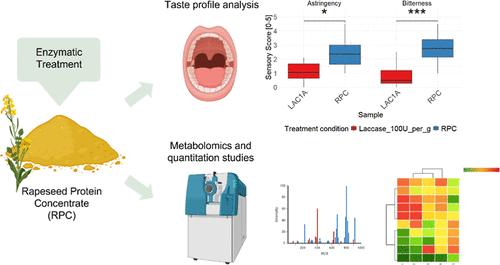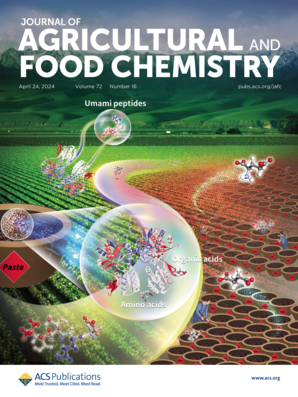Reducing the Bitterness of Rapeseed Protein: Integrating Enzymatic Treatment, Metabolomics, and Sensory Analysis to Elucidate Underlying Mechanisms
IF 5.7
1区 农林科学
Q1 AGRICULTURE, MULTIDISCIPLINARY
引用次数: 0
Abstract
Rapeseed products, such as protein concentrates, hold promise for addressing global protein demands, but their application in food products is limited by their bitter and astringent taste. This study investigates the use of β-glucosidase (BG) and laccase (LAC) enzymatic treatment, individually and combined, to enhance the flavor of rapeseed protein concentrate (RPC). Untargeted metabolomics and sensory analysis reveal that LAC reduces the bitter compound kaempferol 3-O-(2‴-O-sinapoyl-β-D-sophoroside) (K3OSS) as well as a general reduction in other phenolic compounds, which correlates with a significant decrease in bitterness and astringency. In contrast, BG treatment elevates the levels of K3OSS and is accompanied by increased bitterness due to the conversion of precursor compounds to K3OSS. In addition, the synergistic use of both enzymes significantly reduces the concentration of K3OSS, resulting in a lower perception of bitterness. The LC–MS analysis of pure reference compounds treated with LAC and BG confirms that BG-mediated treatment facilitates the breakdown of larger kaempferol glycosides into K3OSS, while LAC treatment promotes polyphenol polymerization. Consequently, LAC treatment seems to be an effective strategy to improve the sensory quality of RPC and make it more suitable for human consumption.

求助全文
约1分钟内获得全文
求助全文
来源期刊
CiteScore
9.90
自引率
8.20%
发文量
1375
审稿时长
2.3 months
期刊介绍:
The Journal of Agricultural and Food Chemistry publishes high-quality, cutting edge original research representing complete studies and research advances dealing with the chemistry and biochemistry of agriculture and food. The Journal also encourages papers with chemistry and/or biochemistry as a major component combined with biological/sensory/nutritional/toxicological evaluation related to agriculture and/or food.

 求助内容:
求助内容: 应助结果提醒方式:
应助结果提醒方式:


